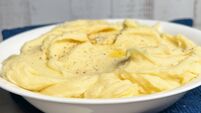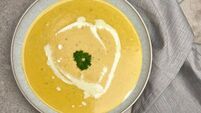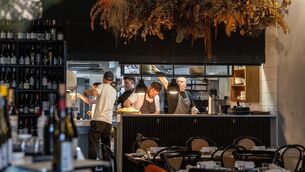Going back to basics with Darina Allen's new book
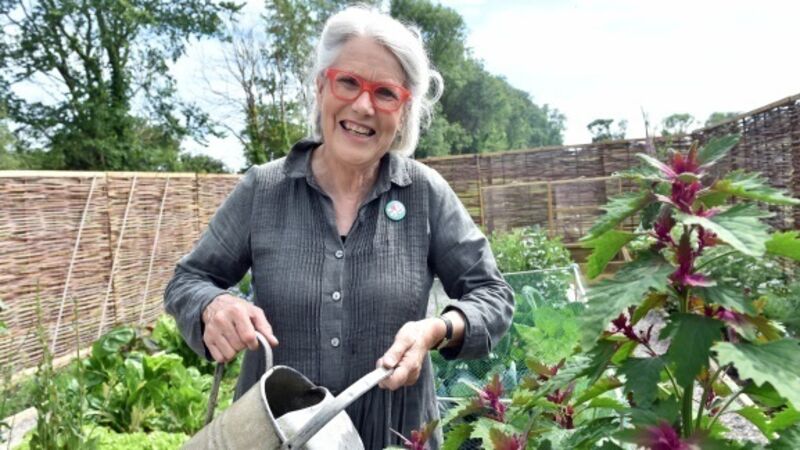
D rawing on over thirty years of growing at Ballymaloe, Darina Allen’s latest book Grow, Cook, Nourish is the ultimate handbook for anybody who wants to start their own kitchen garden. “This may be the most important book that I have ever written because at this point in time it’s where we are with food,” she says from her base at the world-famous cookery school.
The collection of 500 recipes took Allen two and a half years to write, and is a passion project for the doyenne of Irish food.
“Most people are depending on the supermarkets for their food and food choices today. I think it’s hugely urgent for people to start growing for themselves – even just a little. If you sow a seed and wait for it to grow for three months or however long it takes before its ready to eat, it gives you an incredible understanding of farmers and producers who actually grow our food.”
Most of us, says Darina, think of food as something that just appears on our supermarket shelves. “After growing your own, you will never complain about the cost of food again, because you will understand how much goes into it. It is a great education for those of us who are so removed from where food comes from.”
The general public is unaware of issues that affect growth, like weather and crops that fail and as a result are incredibly inpatient, according to Allen. “Farmers and food producers are not being paid enough to produce wholesome nourishing food,” she says.
“When you see carrots in some of the discounters for anything between 20 and 60 cent - it can’t be done! Lets take something back ourselves and grow something. Start in a window box - all you need is a seed, some soil or compost, water, light and a little bit of patience.”
Starting a kitchen garden is not limited to those of us with large outdoor spaces, says Allen. The most impressive results are actually coming from urban gardens. “The whole urban or farming garden movement is a grassroots movement that is now global. Everywhere from Shanghai to Mexico to Brooklyn to London people are growing in cities and it’s turning into a measurable contribution to the whole food system.”
The importance of food welfare means that many of us are eating less meat, and that, according to Allen, is key.
“Vegetables are moving more centre stage,” she asserts. “I think we all agree that we have gotten into the habit of eating huge great lumps of meat and we are eating far too much of it than we need. For a long time lots of people - myself included - have been saying how important it is to buy free range or organic meat, because at this stage we can’t say that we don’t know what are in those cheap chickens or intensely produced pork – it’s there for anyone to look up.”
So what should we be looking out for in autumn? “It’s a wonderful time for growing,” says Allen. “You get the end of the summer harvest and the beginning of the winter root vegetables, but then of course it’s a wonderful season for foraging. It’s the bumper season for foraging really, its when all the berries and the nuts and the sloes and the damsons are there.”
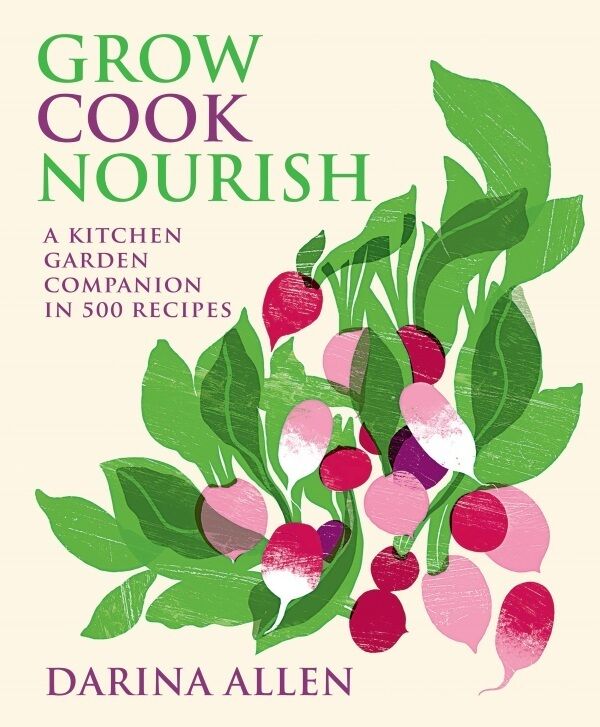
Foraging is an intense passion of Darina’s, and something she is keen to incorporate into Irish people’s diets. “Foraged plants haven’t been in any way tampered with so they have the full complement of vitamins and minerals. This is a skill that’s kind of forgotten, but one that people can re-learn very quickly. We do a foraging course pretty much in every season (Ballymaloe have one starting Friday September 22). Where other people see weeds, I see dinner!”
Tackling food waste is a huge part of Grow, Cook, Nourish. Each chapter has a section on how to use up a glut of fruit or vegetables, and this is an essential part of the kitchen garden arsenal, says Allen. “When you grow your own you are unlikely to waste it. At the moment food is so cheap that people have no respect for it - they buy too much. If you grow something yourself you are much less likely to waste it. If you have a glut of something thou can preserve it. For example if you have the end the tomatoes you can make tomato purées or chutneys, so all of the produce that you grow you will find a way to use it up.”
If there is anyone Darina hopes to resonate with in the release of her new book, it’s young people. She is resolute about the importance of teaching our children how to grow their own food and then, how to cook it. “I hope I live to see the day where our government and Department of Education see the enormous importance of every school having a school garden and teaching our children the life skills they need to feed themselves properly,” she explains. “Teaching them how to sow a seed and then how to cook must be tethered to our curriculum, otherwise we are failing our next generation by not giving them the skills they need and we are making them helpless. If anything comes out of this book, I hope it is this.”
Spinach, Feta & Sweet Potato Frittata

The basic frittata recipe here can be used as a basis for many herbs and vegetables in season, but we love this autumn version.
We use blobs of Ardsallagh or St Tola goat’s cheese in this recipe if we don’t have feta.
- 500g sweet potato or pumpkin, peeled and cut into 1cm dice
- 3 tablespoons extra virgin olive oil, plus extra to serve
- 1 teaspoon flaky sea salt and lots of freshly ground black pepper
- 10 large organic eggs
- 2 tablespoons chopped marjoram
- 2 tablespoons chopped curly parsley
- 2 teaspoons chopped thyme leaves
- 150g perpetual spinach, shredded into 1cm strips (weight 380g before destalking)
- 75g Gruyère cheese, grated
- 25g Parmesan cheese, finely grated
- 25g butter
- 200g feta or fresh goat’s cheese rocket leaves
- 30g toasted Italian pine kernels or cashew nuts, to serve
Preheat the oven to 180°C/gas mark 4.
Put the sweet potato or pumpkin dice onto a small oven tray, drizzle with the olive oil and toss to coat. Season with 1/2 teaspoon flaky sea salt (the feta cheese will be salty so don’t overdo the salt) and lots of freshly ground pepper, stir and cook for 10–15 minutes or until cooked and tender. Remove from the oven.
Whisk the eggs in a bowl, add the remaining salt, freshly ground pepper, chopped herbs, shredded spinach and grated cheese. Melt the butter in a 22.5cm non-stick, ovenproof
frying pan, and when it starts to foam, tip in the eggs.
Sprinkle the roast pumpkin evenly over the surface, dot with the feta or goat’s cheese, and press in gently. Cook for 3–4 minutes over a low heat.
Transfer to the middle shelf of the oven and cook for 25–30 minutes until just set. Flash under the grill for a couple of minutes if colour is needed.
Leave to sit for five minutes before serving.
To serve, slide a palette knife under the frittata to free it from the pan. Slide onto a warm plate. Arrange some rocket leaves on top of the frittata, drizzle with extra virgin olive oil and scatter with toasted pine kernels or coarsely chopped cashew nuts and a few flakes of sea salt.
Pad Thai

Romanesco or broccoli florets are a delicious and nutritious addition to Pad Thai, the famous Thai noodle dish. Use organic ingredients where possible.
- rice noodles
- 1 tablespoon tamarind paste
- 2 tablespoons fish sauce (nam pla)
- 11/2 tablespoons palm sugar or soft brown sugar
- 2 tablespoons freshly squeezed lime juice
- 110g Romanesco or broccoli florets
- 110g carrots, cut into 5cm julienne
- 110ml vegetable oil 2 teaspoons crushed garlic (approx. 5 cloves)
- 1 teaspoon peeled and grated fresh ginger
- 48 Ballycotton shrimps or 16 organic Asian shrimps, cooked and peeled
- 2 organic eggs, beaten
- 3–4 spring onions or scallions, sliced at an angle
- 75g fresh bean sprouts
- 50ml salted peanuts, roughly chopped
- 3 tablespoons chopped fresh coriander
- 1 tablespoon sesame seeds lime wedges red pepper flakes (optional)
- FOR THE CRISPY ONIONS
- 4–6 small onions or shallots
- milk, to cover
- sunflower oil, for frying
Put the noodles into a bowl and cover with water for about an hour.
To make the crispy onions, peel and slice the small onions or shallots very thinly. Separate the rings and allow to dry for several hours. Meanwhile, whisk the tamarind paste, fish sauce, sugar, lime juice and 5ml water in a small bowl.
Blanch and refresh the romanesco or broccoli florets and carrots in boiling salted water – 3 minutes for the broccoli, 2 minutes for the carrots – until al dente. To make the crispy onions, heat the oil to 180°C in a wok or deep-fat fryer. Deep-fry for 2–3 minutes until golden and crisp. Spread them out on kitchen paper in a single layer to cool.
Drain the noodles.
Heat a wok over a high heat, add the oil and continue to heat until almost smoking. Add the garlic and ginger, toss quickly then add the peeled shrimps for a minute or two. Transfer to a plate.
Add the noodles to the wok, stir and fry for a minute. Pour in three quarters of the tamarind paste and fish sauce. Toss to coat the noodles, push to the side of the wok and add the whisked eggs. Stir to scramble a little then add the shrimp, Romanesco or broccoli florets, carrots, spring onions, beansprouts and half of the salted peanuts.
Add the remaining tamarind/fish sauce. Toss, taste and correct the seasoning with more fish sauce and lime juice if necessary.
Divide between four shallow hot plates. Garnish with the remaining peanuts, coriander and a sprinkle of sesame seeds.
Serve each with a lime wedge and a sprinkling of crispy onions and red pepper flakes if you crave some extra oomph. Enjoy.
Braised Lamb Shanks with Garlic, Rosemary & Beans

We also love lamb necks in this delicious gutsy recipe; they need long, slow cooking and benefit from the assertive flavours of rosemary and thyme. This dish tastes even better when cooked a few days ahead.
- 6 lamb shanks, weighing approx. 1kg
- 14 small sprigs of rosemary, plus extra to garnish
- 12 slivers of garlic
- 6 anchovy fillets, halved
- 25g goose or duck fat or olive oil
- 2 carrots, roughly chopped
- 2 celery sticks, roughly chopped
- 1 leek, roughly chopped
- 1 onion, roughly chopped
- 1 garlic, halved horizontally
- 200ml gutsy red wine
- 150ml homemade lamb or chicken stock
- 1 sprig of thyme, plus extra to garnish
- 2 bay leaves
- 2 strips of dried orange peel sprigs of rosemary or thyme
- sea salt and freshly ground black pepper
- green beans, to serve (optional)
- 2 tablespoons extra virgin olive oil
- 110g streaky bacon, cut into lardons and blanched
- 1/2 carrot, finely diced
- 1/2 celery stick, finely diced
- 1/2 onion, finely diced
- 6 garlic cloves
- 4 very ripe tomatoes, peeled and diced or 1/2 x 400g can tomatoes, plus juice
- 2 sprigs of thyme leaves from 2 sprigs of rosemary, chopped
- 225g haricot or borlotti beans, soaked overnight, drained, covered with fresh water and boiled rapidly for 20 minutes
- 150–300ml homemade lamb or chicken stock
Preheat the oven to 150ºC/gas mark 2.
Remove most of the fat from each shank, then scrape the meat away from the bone to loosen it.
Make two deep incisions in each joint and insert a rosemary sprig and a sliver of garlic wrapped in half an anchovy fillet into each incision.
Season the meat with salt and pepper.
Heat the goose or duck fat or olive oil in a heavy sauté pan or casserole and sauté the meat for 5–10 minutes until well browned on all sides. Remove the meat from the pan. Add the carrots, celery, leek, onion and garlic bulb and cook over a high heat for a further 5 minutes until well browned.
Add the wine to the pan and bring to the boil, stir for a minute or two. Add the stock, the remaining rosemary sprigs and the thyme, bay leaves and orange peel to the pan, then place the lamb shanks on top. Cover and cook in the oven for 4 hours.
Meanwhile, make the sauce. Heat the extra virgin olive oil in a saucepan and brown the bacon in it. Then reduce the heat and add the carrot, celery, onion and garlic cloves and cook for about 8 minutes or until the vegetables are soft. Add the tomatoes, beans, and enough stock to half cover the beans.
Cover and simmer for 30–45 minutes or until the beans are cooked but still keep their shape. When the lamb has finished cooking, remove the thyme, bay leaves and orange peel. Season to taste.
Serve the lamb shanks on a hot, deep dish with the beans and vegetables poured over and around. Garnish with sprigs of rosemary and thyme. There will be lots of delicious cooking juices in the braising pot. Drain, save and use in a soup or as a basis for stews or gravy.



